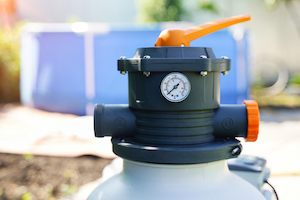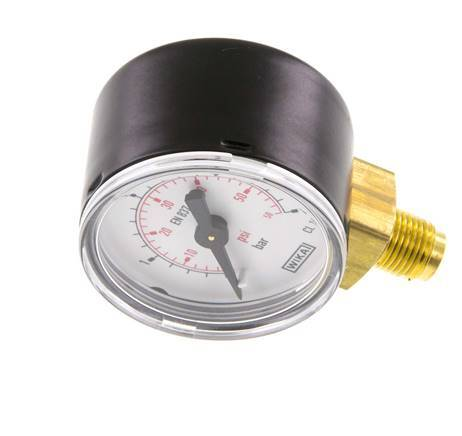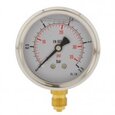Pool Filter Pressure Gauge

Figure 1: Pressure gauge on a pool filter system
A pool filter pressure gauge measures the pressure inside the pool's filtration system. This helps determine when it's time to clean or replace the filter or other plumbing components, ensuring the pool water remains safe, clean, and clear. This article discusses the role of a pool filter pressure gauge in maintaining the proper functioning of a swimming pool and explains how to interpret its readings to assess the overall condition of the pool's filtration system.
Table of contents
- What is a pool filter gauge?
- Optimal pool filter pressure
- Too high pressure
- Too low pressure
- Other methods to troubleshoot a pool filter gauge
- Pool pressure gauge maintenance and replacement
- FAQs
View our online selection of pool filter pressure gauges!
What is a pool filter gauge?
A pool filter pressure gauge is typically a bourdon tube element located on top of the filter, and measures the amount of pressure building up inside the filter. A typical pressure gauge is round, with an indicator needle and a range from 0 to a maximum reading of 4 bar (0 - 58 psi).
When water flows through a pool filter as intended, the pressure within the filter remains steady. Any fluctuations indicated by the pressure gauge may suggest that water is not flowing through the filter as it should. Read our water pressure gauge article for more details on the working and selection criteria of pressure gauges used for water.

Figure 2: Wika pressure gauge for pool filter
Optimal pool filter pressure
When maintaining a pool filter system, it's crucial to monitor the base pressure, which is the reading taken after thorough backwashing (a process that involves reversing the flow of water through the filter to clean out trapped debris and contaminants). Record a baseline reading each time the filter is installed or replaced, as it serves as a reference for ideal pressure levels. A normal pressure gauge reading is around 0.7 bar (10 psi), but this can vary. Consult the manufacturer or a pool professional to determine what's normal for the specific pool model, as pressure depends on the flow rate and pump horsepower. Always ensure the pump's horsepower matches the filter's capacity, and refer to the pump's chart for ideal flow rates based on pool and filter size.
The pressure reading on the pool filter gauge depends on several factors, such as:
- Pool and filter size
- How clean the filter is at the moment
- The condition of the pool water
- The pool's plumbing system
- The pool system setup
Too high pressure
Over time, as the pool filter operates, the filter media gradually accumulates dirt, oils, and impurities. As this buildup occurs, it becomes increasingly difficult for water to pass through the filter media, leading to a rise in pressure inside the tank.
If the pressure rises more than 0.3 - 0.7 bar (5 -10 psi) above the baseline, the filter is likely clogged. This can strain the pump motor, impacting water circulation and cleaning efficiency. According to industry standards, when the gauge shows 10 psi above the normal baseline, it's time to clean or potentially replace the filter. If the filter has been cleaned recently and the pressure level remains above normal, it is important to inspect the filter system for leaks. If the pressure increases steeply, shut off the pump and check for the following issues:
- Broken internal filter parts
- Dirty pool filter
- Closed or partially closed return side pool valves
- Lime deposits inside the gas heater's heat exchanger
Too low pressure
A decrease in pressure indicated by the pool filter pressure gauge generally suggests an issue with the water flow before it reaches the filter:
- There may be an obstruction in the skimmer basket, pump basket, pump, or main drain.
- Other causes of low pressure can be a low water level, an undersized pump, or a leak somewhere in the system.
Air can sometimes accumulate in the filter during routine maintenance, such as cleaning the pump basket or backwashing the filter, and over time, this trapped air increases the pressure within the filter. A common cause of this is a low water level, which allows air to enter through the skimmers. It's advisable to open the air release valve, also known as a bleeder, each time the pump is turned on. This is because air can build up at the top of the filter when it's off, reducing its effectiveness. To remove the trapped air, simply open the release valve and wait until water starts to come out. Then, close the valve to ensure the filter is free of air.
Other methods to troubleshoot a pool filter gauge
Zero pressure reading (stuck gauge)
Causes:
- The air bleeder assembly under the gauge may be clogged.
- The dial may be bent due to rust (in metal gauges) or warping from sunlight (in plastic gauges).
Solutions:
- Gently tap the gauge to see if it becomes active.
- Turn off the pump; the gauge should read zero. If not, clean the gauge. Remove the gauge and air bleeder assembly, then clean the air relief valve.
- If the needle remains stuck due to a bent dial, replace the gauge.
Filter pressure gauge on the pool is leaking water
- Cause: It is often the air relief assembly, not the gauge itself, that is leaking.
-
Solution:
- Repair the air relief valve by wrapping Teflon tape around the threads to ensure a tight seal.
- Replace the o-ring on the valve knob to prevent leaks.
- If the leak persists, install a new air relief valve.
Broken pool filter gauge
If the filter pressure remains unchanged for several weeks or if the gauge doesn't return to zero when the pump is turned off, it may indicate a malfunctioning gauge.
Causes:
- An obstructed air bleeder assembly beneath the gauge.
- A faulty gauge that does not reset to zero.
Solutions:
- Remove the gauge and clean it thoroughly to clear any obstructions.
- Replace the gauge if it still does not move after cleaning or fails to return to zero when the pump is off.
Pool pressure gauge maintenance and replacement
As part of the regular pool maintenance schedule:
- Check the pressure gauge on the pool filter at least once a week. If the gauge readings are moving too far in either direction, address it immediately.
- Note the gauge readings so it can easily be seen if and when the pressure starts to drop or rise. This helps determine if something is wrong for system troubleshooting.
Replace the pressure gauge in the following cases:
- If the pressure gauge provides incorrect or inconsistent readings, such as a pressure reading that is extremely high one day and significantly below normal the next, or if the gauge reads high or low without any apparent reason, it may be necessary to replace it.
- The pressure gauge should also be replaced if it is cracked, rusted, or exhibits any other signs of wear.
Note: Turn off the pump and use the air relief valve before replacing the pressure gauge.
Read our article on troubleshooting pressure gauges for more details on maintenance and troubleshooting pressure gauge issues.
FAQs
How high should the air pressure be on a pool filter?
Clean the filter when the pressure reading exceeds 0.7 bar (10 psi) above the base measurement. Take base measurements after cleaning and backwashing the filter to ensure proper pool operation.
How will I know if my pool pressure gauge is defective?
A broken gauge may read zero or be warped when the pump is on, indicating distortion or deformation due to exposure to high pressures that cause inaccuracies in gauge readings.
What is a pool sand filter pressure gauge?
A sand filter is a filter type that removes suspended, floating, and sinkable particles. A pressure gauge for a pool sand filter helps determine when it's time to clean or replace the filter.
What should the pressure gauge for the pool pump read?
A pool pump pressure gauge should normally read between 0.7 - 1.4 bar (10 - 20 psi).








